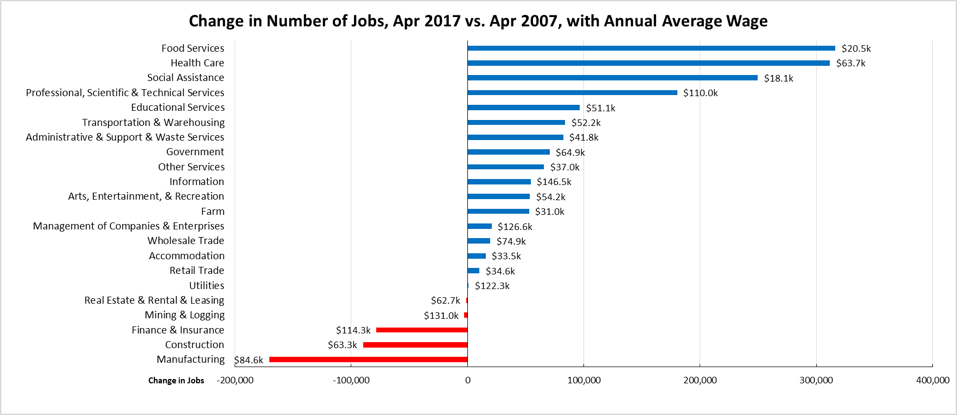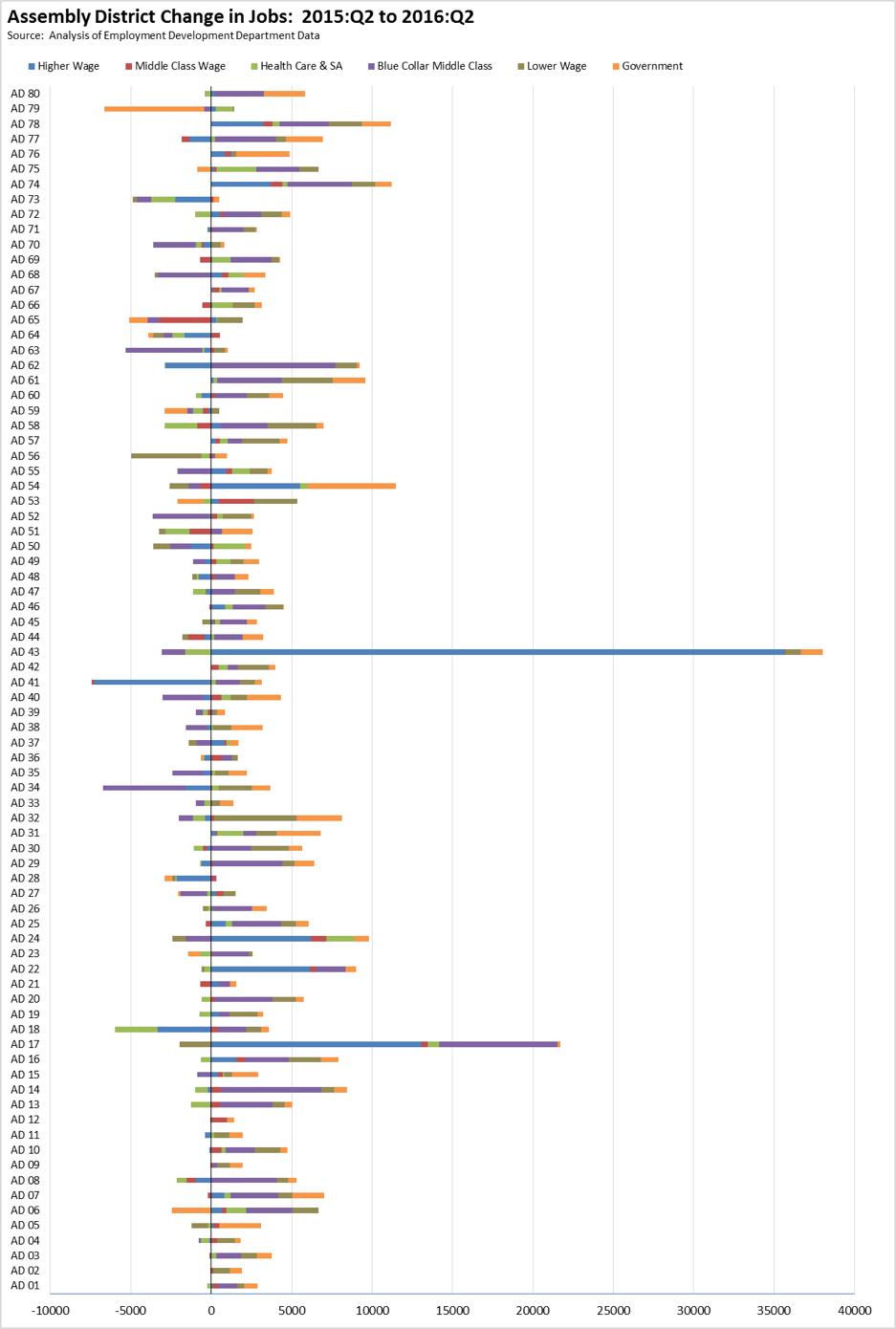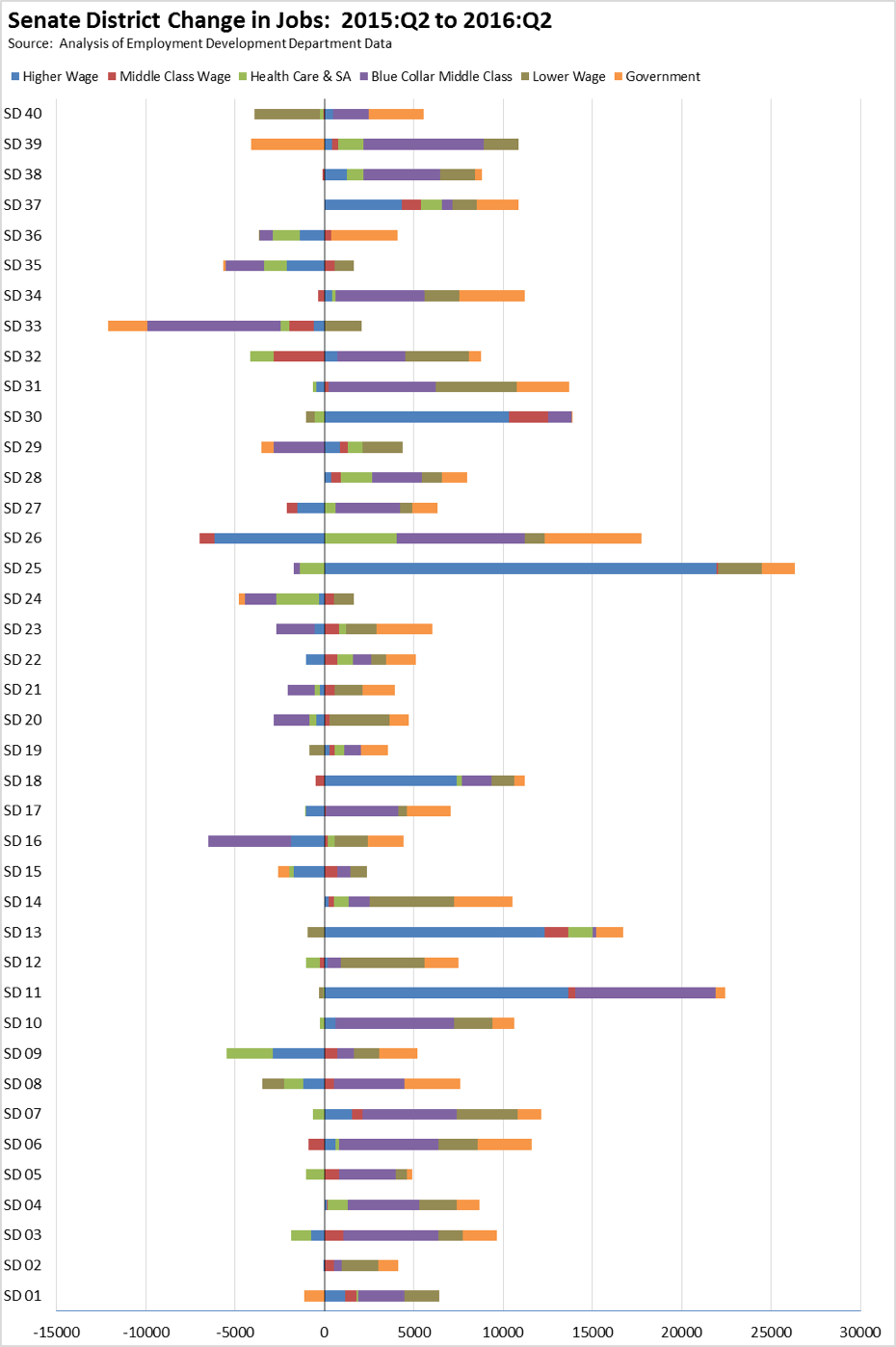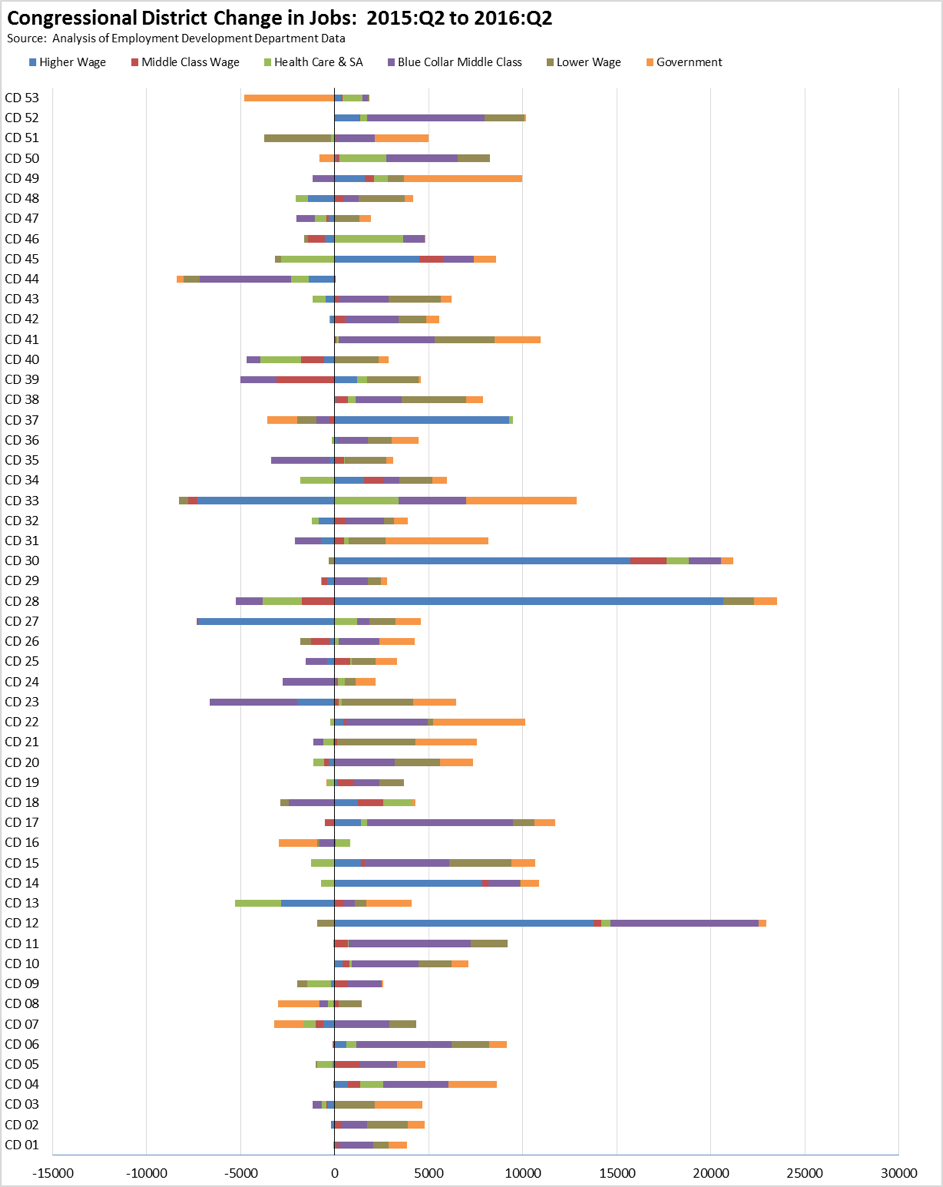Highlights for policy makers:
- Unemployment Rate Eases to 4.8%; Total Employment Up 27,800
- Labor Force Participation Rate Level Unchanged at 62.1%
- State Employment Growth Rankings—California Remains in 2nd Place Behind Florida
- Nonfarm Jobs Down 16,300
- 5 Industries Below 2007 Pre-Recession Job Levels
- Job Gains by Wage Level
- 2016:Q2 Jobs, Wage & Establishment Data Updated
- Two-Tier Economy Persists—Central Valley Unemployment Nearly Twice as High as Bay Area
- Bay Area Provided 42% of Net Employment Growth Since Recession
- 8 California MSAs in the 10 Worst Unemployment Rates Nationally
Unemployment Rate Eases to 4.8%; Total Employment Up 27,800
The Labor Force data for April 2017 (seasonally adjusted; California preliminary) is shown below, along with the change from the prior month:
| Seasonally Adjusted | California | US | ||
|---|---|---|---|---|
| Apr 2017 | Change from Mar 2017 | Apr 2017 | Change from Mar 2017 | |
| Unemployment Rate | 4.8 | -0.1 | 4.4 | -0.1 |
| Labor Force | 19,177,900 | 0.0% | 160,213,000 | 0.0% |
| Participation Rate | 62.1 | 0.0 | 62.9 | -0.1 |
| Employment | 18,254,700 | 0.2% | 153,156,000 | 0.1% |
| Unemployment | 923,200 | -2.1% | 7,056,000 | -2.0% |
The related not seasonally adjusted numbers (California preliminary), with the change from April 2016:
| Not Seasonally Adjusted | California | US | ||
|---|---|---|---|---|
| Apr 2017 | Change from Apr 2016 | Apr 2017 | Change from Apr 2016 | |
| Unemployment Rate | 4.5 | -0.9 | 4.1 | -0.6 |
| Labor Force | 19,084,500 | 0.3% | 159,817,000 | 0.8% |
| Participation Rate | 61.8 | -0.4 | 62.8 | 0.1 |
| Employment | 18,222,000 | 1.2% | 153,262,000 | 1.4% |
| Unemployment | 862,500 | -15.4% | 6,555,000 | -11.6% |
California Employment Development Department’s (EDD) latest release shows on a seasonally adjusted basis, total employment rose 27,800 from March, while the number of unemployed dropped by 20,200. The labor force grew by only 7,600.
California’s seasonally adjusted unemployment rate continued easing to 4.8%. California tied with West Virginia for the 14th highest unemployment rate among the states. The unadjusted rate dropped from 5.4% in April 2016 to 4.5%.
Total US employment saw a seasonally adjusted increase of 156,000 from March, while the number of unemployed dropped by 146,000. The national unemployment rate continued easing 0.1 point to 4.4%. The national labor force numbers also remained essentially level with a gain of only 12,000.
Labor Force Participation Rate Level Unchanged at 62.1%
California’s participation rate (seasonally adjusted) remained unchanged in April at 62.1%, while the US rate notched down 0.1 point to 62.9%. The California participation rate still remains near the previous lows from 1976, and well below the average pre-recession level of 65.6% in 2007.
Compared to November 2016, growing business and consumer confidence has seen the national labor force grow by 757,000 and the participation rate by 0.3 percentage point as workers have been drawn back into the labor force. In California, the labor force has remained essentially unchanged (net decline of 13,700), while the rate has dropped 0.2 points.
State Employment Growth Rankings—California Remains in 2nd Place Behind Florida
| Rank | Number of Employed | Percentage Change | Population Adjusted (employment growth per 1,000 civilian noninstitutional population) |
|---|---|---|---|
| 1 | FL 390,000 | KY 4.8% | UT 30.2 |
| 2 | CA 272,600 | UT 4.6% | KY 26.0 |
| 3 | TX 266,500 | FL 4.2% | FL 23.6 |
| 4 | NY 165,600 | AZ 3.9% | CO 22.3 |
| 5 | GA 156,700 | CO 3.4% | AZ 22.0 |
| 6 | AZ 117,700 | OR 3.4% | OR 20.4 |
| 7 | MI 109,100 | GA 3.4% | GA 19.9 |
| 8 | NC 108,600 | MA 3.1% | MA 19.3 |
| 9 | MA 106,400 | ME 3.1% | ME 18.6 |
| 10 | WA 98,700 | MS 3.1% | WA 17.3 |
| 11 | CO 95,900 | WA 2.9% | HI 16.8 |
| 12 | VA 90,000 | HI 2.8% | MS 16.2 |
| 13 | KY 89,900 | NV 2.7% | NV 15.7 |
| 14 | OH 70,600 | SC 2.6% | ND 15.1 |
| 15 | TN 70,600 | AL 2.5% | SC 14.4 |
| 16 | MD 68,000 | MI 2.4% | MD 14.4 |
| 17 | OR 66,600 | TN 2.4% | MI 13.8 |
| 18 | UT 66,000 | NC 2.4% | NC 13.8 |
| 19 | PA 61,000 | MD 2.2% | VA 13.8 |
| 20 | WI 60,500 | VA 2.2% | TN 13.6 |
| 21 | NJ 58,400 | ND 2.2% | CT 13.5 |
| 22 | SC 55,900 | CT 2.2% | AL 13.3 |
| 23 | AL 50,800 | TX 2.1% | WI 13.3 |
| 24 | IN 44,200 | ID 2.0% | DC 12.9 |
| 25 | IL 39,400 | WI 2.0% | TX 12.8 |
| 26 | CT 38,700 | DC 2.0% | ID 12.5 |
| 27 | MS 36,900 | NY 1.8% | RI 10.6 |
| 28 | NV 35,900 | RI 1.7% | NY 10.5 |
| 29 | MN 35,300 | AK 1.6% | AK 9.9 |
| 30 | ME 20,400 | CA 1.5% | CA 8.9 |
| US 2,128,000 | US 1.4% | US 8.4 |
Between April 2016 and April 2017, Bureau of Labor Statistics (BLS) data shows the total number of employed in California increased by 272,600 (seasonally adjusted), or 12.8% of the total net employment gains in this period for the US. California remained in 2nd place behind Florida (which has a civilian working age population only 55% as large as California’s) at 390,000, with Texas in a close third at 266,500. Measured by percentage change in employment over the year, California dropped to 30th highest. Adjusted for population, California dropped to 30th as well.
Nonfarm Jobs Down 16,300
EDD reported that between March and April 2017, seasonally adjusted nonfarm wage and salary jobs dropped 16,300 in April. March’s gains were revised up to 22,800 from the previously reported gain of 19,300.
Looking at the not seasonally adjusted numbers, hiring saw increases in all but four industries over the year. The change in total payroll jobs from April 2016 saw the largest increases in Government (51,400) as tax and fee revenues have continued to expand, Construction (31,800), and Food Services (34,400). Declines were in Manufacturing (-10,000), Information (-5,100), and Administrative, Support & Waste Services (-2,300).
| Not Seasonally Adjusted Payroll Jobs | Apr 2017 | Mar 2017 | Change Apr 2017 – Mar 2017 | Change Apr 2017 – Apr 2016 |
|---|---|---|---|---|
| Total Farm | 433,200 | 371,800 | 61,400 | -3,200 |
| Mining & Logging | 22,500 | 22,100 | 400 | -1,800 |
| Construction | 800,700 | 787,400 | 13,300 | 37,800 |
| Manufacturing | 1,290,100 | 1,292,900 | -2,800 | -10,000 |
| Wholesale Trade | 731,400 | 733,300 | -1,900 | 10,500 |
| Retail Trade | 1,662,900 | 1,659,900 | 3,000 | 5,100 |
| Utilities | 58,500 | 58,300 | 200 | -400 |
| Transportation & Warehousing | 526,400 | 529,000 | -2,600 | 9,100 |
| Information | 519,500 | 525,000 | -5,500 | -5,100 |
| Finance & Insurance | 545,800 | 546,400 | -600 | 2,800 |
| Real Estate & Rental & Leasing | 279,900 | 279,800 | 100 | 3,500 |
| Professional, Scientific & Technical Services | 1,232,300 | 1,236,100 | -3,800 | 12,700 |
| Management of Companies & Enterprises | 227,400 | 227,700 | -300 | 2,900 |
| Administrative & Support & Waste Services | 1,068,800 | 1,076,200 | -7,400 | -2,300 |
| Educational Services | 379,600 | 380,900 | -1,300 | 10,100 |
| Health Care | 1,478,800 | 1,484,800 | -6,000 | 28,000 |
| Social Assistance | 753,600 | 745,500 | 8,100 | 27,400 |
| Arts, Entertainment, & Recreation | 302,400 | 296,000 | 6,400 | 4,300 |
| Accommodation | 222,700 | 220,800 | 1,900 | 2,000 |
| Food Services | 1,408,700 | 1,395,500 | 13,200 | 34,400 |
| Other Services | 573,100 | 571,900 | 1,200 | 18,200 |
| Government | 2,595,500 | 2,594,700 | 800 | 51,400 |
| Total Nonfarm | 16,680,600 | 16,664,200 | 16,400 | 240,600 |
| Total Wage & Salary | 17,113,800 | 17,036,000 | 77,800 | 237,400 |
By total number of new jobs, California dropped to the second highest increase in seasonally adjusted nonfarm jobs among the states from April 2016 to April 2017, at 236,700 or 10.6% of the US net increase. Texas (with a civilian working age population only 68% as large as California’s) leading with 258,900 jobs and Florida a close third with 215,400. By percentage growth in jobs, California dropped to 21st highest at 1.4%, below the US average of 1.6%. By population adjusted jobs growth, California dropped to 25th highest, also below the US average.
| Rank | Number of Jobs | Employment Growth (%) | Population Adjusted (job growth per 1,000 civilian noninstitutional population) |
|---|---|---|---|
| 1 | TX 258,900 | NV 3.6% | UT 20.9 |
| 2 | CA 236,700 | UT 3.3% | NV 19.8 |
| 3 | FL 215,400 | ID 2.6% | GA 14.3 |
| 4 | GA 113,600 | GA 2.6% | ID 14.2 |
| 5 | NY 97,800 | FL 2.6% | WA 14.1 |
| 6 | WA 81,700 | WA 2.5% | FL 12.8 |
| 7 | MI 73,600 | OR 2.3% | OR 12.6 |
| 8 | MA 58,600 | TX 2.2% | TX 12.2 |
| 9 | TN 57,000 | AZ 2.0% | SD 12.0 |
| 10 | NC 53,300 | TN 1.9% | MN 11.4 |
| 11 | AZ 53,200 | SD 1.8% | NH 11.0 |
| 12 | NJ 51,600 | NH 1.8% | TN 10.8 |
| 13 | MN 49,300 | CO 1.8% | MA 10.5 |
| 14 | UT 46,700 | MT 1.7% | CO 10.4 |
| 15 | NV 46,200 | MI 1.7% | AZ 9.8 |
| 16 | CO 45,700 | MN 1.7% | MT 9.8 |
| 17 | PA 45,300 | MD 1.7% | MD 9.5 |
| 18 | MD 45,000 | MA 1.7% | MI 9.3 |
| 19 | VA 44,400 | KY 1.6% | KY 9.0 |
| 20 | OR 42,000 | AR 1.5% | HI 8.3 |
| 21 | WI 37,600 | CA 1.4% | WI 8.2 |
| 22 | MO 36,700 | HI 1.4% | NE 7.9 |
| 23 | OH 35,900 | SC 1.4% | AR 7.7 |
| 24 | KY 31,200 | AL 1.3% | MO 7.7 |
| 25 | IN 31,100 | MO 1.3% | CA 7.7 |
| US 2,237,000 | US 1.6% | US 8.8 |
5 Industries below 2007 Pre-Recession Job Levels

Comparing the number of jobs by industry in April 2017 (not seasonally adjusted), 5 industries had employment below the 2007 pre-recession levels. In the highest gain industries, lower wage Food Services overtook Health Care as the leading industry, while lower wage Social Assistance and higher wage Professional, Scientific & Technical Services remained in 3rd and 4th place, respectively. Of the lagging industries, three—Manufacturing, Mining & Logging, and Construction—are blue collar middle class wage industries, while the higher wage Finance & Insurance also continued to lose ground.
Job Gains by Wage Level
In the recent May Budget Revision, the Governor again pointed to the increasing share of lower wage jobs as one of the prime causes of slowing state revenues growth: “The level of wages has been revised downward, and cash receipts have been significantly below forecast.” The following chart illustrates this trend, according to the industry wage classification used previously in other Center analyses of this issue. In the chart below, Private sector jobs are shown in the dark green bands, while Government is shown in the lighter. As indicated, over one-third of jobs growth over the past 12 months has been in the low-wage industries.

2016:Q2 Jobs, Wage and Establishment Data Updated
Jobs, wage, and establishment data from Quarterly Census of Employment & Wages (QCEW) has been updated and available through the Employment Data Tool. The most recent data covers 2016:Q2. The update also includes revisions to the earlier year data for the Legislative Districts.
Changes in jobs by wage level for the year 2015:Q2 to 2016:Q2 are summarized in the charts below for Congressional, Senate, and Assembly Districts. The wage categories are similar to those presented above for the state, but some differences exist due to the current availability of data at the legislative district level. The main difference is that Health Care and the lower wage Social Assistance jobs are reported together in the data. Compared to the state data above, the charts below therefore undercount the extent to which “lower wage” jobs affect the mix in each district
As with prior QCEW updates at the district level, the data continues to show sharp disparities among the districts:
- Four Assembly Districts (AD 43, AD 17, AD 74, and AD 78) accounted for nearly a third (31.5%) of the net jobs gains during this 12-month period.
- Four Senate Districts (SD 25, SD 11, SD 13, and SD 31) accounted for nearly the same share (30.2%).
- Four Congressional Districts (CD 12, CD 30, CD 28, and CD 17) accounted for 29.1% of net jobs gains.
Moreover, job gains in these 12 districts were led by the higher wage industries. The other 161 districts with considerably lower job growth generally saw their numbers dependent to a greater extent on lower wage job growth.
Combining these results with the continuing Two-Tier developments discussed in the next section again reinforces the conclusion that current state policies affecting the state’s business climate primarily generate growth in a few areas of the state rather than providing more widespread job and wage growth across California.



Two-Tier Economy Persists—Central Valley Unemployment More than Twice as High as Bay Area
Unemployment rates (all data is not seasonally adjusted) continue to vary widely across the state, ranging from 3.2% in the Bay Area to nearly three times as large at 8.8% in the Central Valley.
| Not Seasonally Adjusted | Unemployment Rate (%) April 2017 |
|---|---|
| California | 4.5 |
| Bay Area | 3.2 |
| Orange County | 3.3 |
| Los Angeles | 4.1 |
| Sacramento Region | 4.4 |
| San Diego/Imperial | 4.4 |
| Inland Empire | 4.7 |
| Central Sierra | 4.9 |
| Central Coast | 6.0 |
| Upstate California | 6.4 |
| Central Valley | 8.8 |
By Legislative District:
| Lowest 10 Unemployment Rates: | |||||
|---|---|---|---|---|---|
| CD12 (Pelosi-D) | 2.6 | SD13 (Hill-D) | 2.4 | AD16 (Baker-R) | 2.2 |
| CD18 (Eshoo-D) | 2.6 | SD11 (Wiener-D) | 2.8 | AD22 (Mullin-D) | 2.2 |
| CD52 (Peters-D) | 2.7 | SD37 (Moorlach-R) | 2.9 | AD24 (Berman-D) | 2.5 |
| CD45 (Walters-R) | 2.7 | SD39 (Atkins-D) | 2.9 | AD28 (Low-D) | 2.6 |
| CD14 (Speier-D) | 2.8 | SD36 (Bates-R) | 3.0 | AD77 (Maienschein-R) | 2.7 |
| CD17 (Khanna-D) | 2.9 | SD26 (Allen-D) | 3.0 | AD17 (Chiu-D) | 2.7 |
| CD33 (Lieu-D) | 3.0 | SD07 (Glazer-D) | 3.2 | AD19 (Ting-D) | 2.8 |
| CD15 (Swalwell-D) | 3.0 | SD10 (Wieckowski-D) | 3.3 | AD73 (Brough-R) | 2.8 |
| CD49 (Issa-R) | 3.1 | SD15 (Beall-D) | 3.3 | AD78 (Gloria-D) | 2.8 |
| CD27 (Chu-D) | 3.1 | SD32 (Mendoza-D) | 3.3 | AD74 (Harper-R) | 2.9 |
| Highest 10 Unemployment Rates | |||||
|---|---|---|---|---|---|
| CD44 (Barragán-D) | 5.8 | SD21 (Wilk-R) | 4.9 | AD12 (Flora-R) | 6.5 |
| CD03 (Garamendi-D) | 6.0 | SD17 (Monning-D) | 5.0 | AD03 (Gallagher-R) | 7.1 |
| CD09 (McNerney-D) | 6.5 | SD35 (Bradford-D) | 5.0 | AD34 (Fong-R) | 7.5 |
| CD20 (Panetta-D) | 7.0 | SD04 (Nielsen-R) | 5.8 | AD13 (Eggman-D) | 7.6 |
| CD10 (Denham-R) | 7.3 | SD05 (Galgiani-D) | 7.0 | AD23 (Patterson-R) | 7.7 |
| CD23 (McCarthy-R) | 8.0 | SD08 (Berryhill-R) | 7.2 | AD26 (Mathis-R) | 9.7 |
| CD22 (Nunes-R) | 8.2 | SD16 (Fuller-R) | 7.7 | AD21 (Gray-D) | 10.0 |
| CD51 (Vargas-D) | 9.2 | SD40 (Hueso-D) | 7.7 | AD31 (Arambula-D) | 10.1 |
| CD16 (Costa-D) | 10.2 | SD12 (Cannella-R) | 8.7 | AD56 (Garcia-D) | 10.4 |
| CD21 (Valadao-R) | 10.9 | SD14 (Vidak-R) | 11.7 | AD32 (Salas-D) | 11.5 |
Bay Area Provided 42% of Net Employment Growth Since Recession
Containing just under 20% of the state’s population, the Bay Area was responsible for 42.1% of the net growth in employment since the pre-recession peak in 2007. Los Angeles Region provided the next largest share at 21.2%, but spread over 29.3% of the population. Inland Empire is the only other region where employment growth has exceeded population.

8 California MSAs in the 10 Worst Unemployment Rates Nationally
Of the 10 Metropolitan Statistical Areas (MSAs) with the worst unemployment rates nationally, 8 are in California. Of the 20 worst, 12 are in California.
| Metropolitan Area | March 2017 rate | Rank |
|---|---|---|
| Brownsville-Harlingen, TX Metropolitan Statistical Area | 7.9 | 368 |
| Rockford, IL Metropolitan Statistical Area | 8.3 | 370 |
| Stockton-Lodi, CA Metropolitan Statistical Area | 8.3 | 370 |
| Yakima, WA Metropolitan Statistical Area | 8.3 | 370 |
| Youngstown-Warren-Boardman, OH-PA Metropolitan Statistical Area | 8.3 | 370 |
| Farmington, NM Metropolitan Statistical Area | 8.4 | 374 |
| McAllen-Edinburg-Mission, TX Metropolitan Statistical Area | 8.5 | 375 |
| Santa Cruz-Watsonville, CA Metropolitan Statistical Area | 8.5 | 375 |
| Modesto, CA Metropolitan Statistical Area | 8.8 | 377 |
| Madera, CA Metropolitan Statistical Area | 10.0 | 378 |
| Salinas, CA Metropolitan Statistical Area | 10.1 | 379 |
| Fresno, CA Metropolitan Statistical Area | 10.3 | 380 |
| Yuba City, CA Metropolitan Statistical Area | 10.4 | 381 |
| Hanford-Corcoran, CA Metropolitan Statistical Area | 11.2 | 382 |
| Bakersfield, CA Metropolitan Statistical Area | 11.5 | 383 |
| Ocean City, NJ Metropolitan Statistical Area | 12.1 | 384 |
| Merced, CA Metropolitan Statistical Area | 12.2 | 385 |
| Visalia-Porterville, CA Metropolitan Statistical Area | 12.3 | 386 |
| Yuma, AZ Metropolitan Statistical Area | 12.8 | 384 |
| El Centro, CA Metropolitan Statistical Area | 19.2 | 388 |
